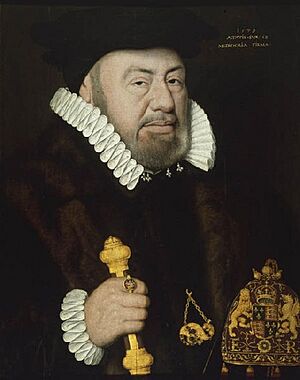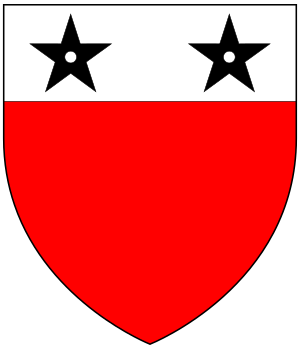Nicholas Bacon (Lord Keeper) facts for kids
Quick facts for kids
Nicholas Bacon
|
|
|---|---|

Sir Nicholas Bacon by an unknown artist, 1579
|
|
| Lord Keeper of the Great Seal | |
| In office c. 1558 – c. 1571 |
|
| Preceded by | Nicholas Heath, Archbishop of York (Lord Chancellor) |
| Succeeded by | Sir Thomas Bromley |
| Lord Keeper of the Privy Seal | |
| In office c. 1558 – c. 1579 |
|
| Preceded by | William Paget, 1st Baron Paget |
| Succeeded by | William Cecil, 1st Baron Burghley |
| Personal details | |
| Born | 13 October 1510 Chislehurst, England |
| Died | 20 February 1579 (aged 68) London |
| Spouses | Jane Ferneley Anne Cooke |
| Children | Sir Nicholas Bacon, 1st Baronet, of Redgrave Sir Edward Bacon Sir Nathaniel Bacon Elizabeth Bacon Anne Bacon Elizabeth Bacon (again) Anthony Bacon Sir Francis Bacon |
| Parents | Robert Bacon, Isabel Cage |
Sir Nicholas Bacon (born December 28, 1510 – died February 20, 1579) was a very important person in England during the time of Queen Elizabeth I of England. He held a big job called the Lord Keeper of the Great Seal. He was also the father of a famous thinker and leader, Sir Francis Bacon.
Contents
Life of Nicholas Bacon
Early Life and Education
Nicholas Bacon was born in Chislehurst, Kent, England. He was the second son of Robert Bacon and Eleanor (also known as Isabel) Cage.
He went to Corpus Christi College, Cambridge and finished his studies in 1527. There's even a law society at the college named after him, called the Nicholas Bacon Law Society.
Nicholas studied law and became a lawyer in 1533. He spent some time in Paris before joining Gray's Inn, which was a famous place for lawyers.
Building Gorhambury House
After King Henry VIII closed down many monasteries, Nicholas Bacon received land grants. These included areas like Redgrave and Gorhambury, Hertfordshire.
Gorhambury was near an old Roman city called Verulamium (now St Albans). Between 1563 and 1568, Nicholas built a new home there called Old Gorhambury House. Later, his youngest son, Francis Bacon, owned this house.
Rise to Power and Royal Service
In 1545, Nicholas Bacon became a Member of Parliament for Dartmouth. The next year, he got a powerful and well-paid job as Attorney of the Court of Wards and Liveries. By 1552, he was the treasurer of Gray's Inn.
When Queen Mary I of England ruled, Nicholas lost some of his influence because he was a Protestant. But when her sister Elizabeth became Queen in 1558, his luck changed.
He was appointed Lord Keeper of the Great Seal, thanks to his brother-in-law, William Cecil. Soon after, Queen Elizabeth made Nicholas Bacon a knight.
Nicholas helped his friend Matthew Parker become the Archbishop of Canterbury. He also led the House of Lords when Queen Elizabeth opened her first parliament.
Political Views and Challenges
Nicholas Bacon did not trust Mary, Queen of Scots. He disagreed with William Cecil's idea of going to war with France because of the cost. However, he wanted England to have stronger ties with other Protestant countries. He also saw the danger of France and Scotland working together against England.
In 1559, he was given the full power of the Lord Chancellor. In 1564, he temporarily lost the Queen's favor. Elizabeth thought he was involved in a pamphlet that supported Lady Katherine Grey's claim to the English throne.
After it was proven he was innocent, he was back in the Queen's good graces. He continued to distrust Mary, Queen of Scots. He also warned Elizabeth about the dangers of marrying her to Thomas Howard, 4th Duke of Norfolk.
Nicholas Bacon was also worried about the proposed marriage between Queen Elizabeth and François, Duke of Anjou. His distrust of Catholics and the French grew even more after the terrible St Bartholomew's Day massacre. As a loyal member of the English church, he was always interested in religious matters. He often suggested ways to improve church rules and beliefs.
Death and Lasting Impact
Nicholas Bacon passed away in London and was buried in Old St Paul's Cathedral. Many people spoke highly of him. Sadly, his grave and monument were destroyed in the Great Fire of London in 1666. A modern monument in the cathedral's crypt remembers him among other important people whose graves were lost.
He was known as a great speaker, a smart lawyer, and a kind friend. He cared a lot about education and gave money and gifts for schools. This included starting a free grammar school in Redgrave, Suffolk.
Family and Children
Nicholas Bacon was married twice and had many children.
His first marriage was to Jane Ferneley (who died in 1552). Nicholas and Jane had six children who lived:
- Sir Nicholas Bacon, 1st Baronet, of Redgrave (around 1540–1624).
- Edward Bacon (1548/9 – 1618).
- Sir Nathaniel Bacon (around 1546 – November 1622).
- Elizabeth Bacon, who married three times.
- Anne Bacon, who married Sir Henry Woodhouse.
- Elizabeth Bacon (another daughter with the same name), who also married twice.
Sir Nicholas Bacon's second marriage was in 1553 to Anne Cooke (1528–1610). She was the daughter of Sir Anthony Cooke. With Anne, he had two sons:
- Anthony Bacon (1558–1601).
- Francis Bacon (1561–1626), who became a very famous Lord Chancellor, philosopher, writer, and scientist.




